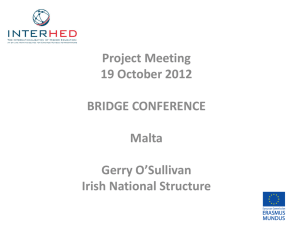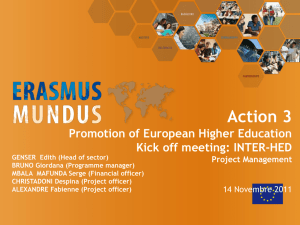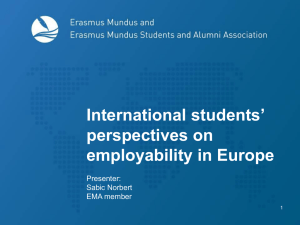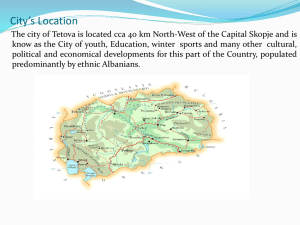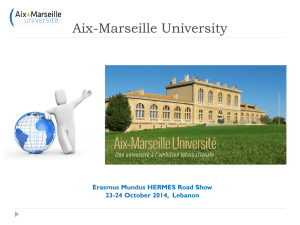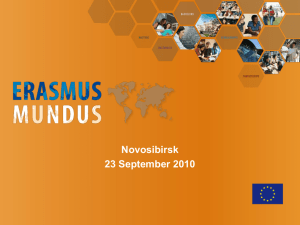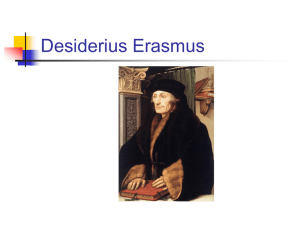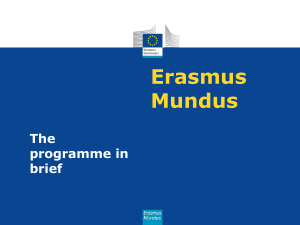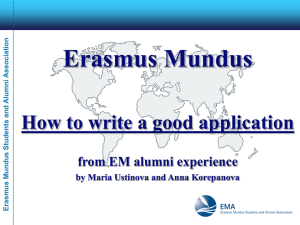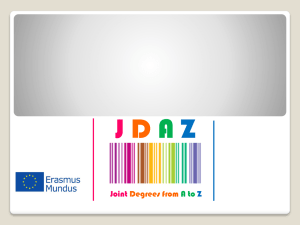Recognition Outcomes
advertisement
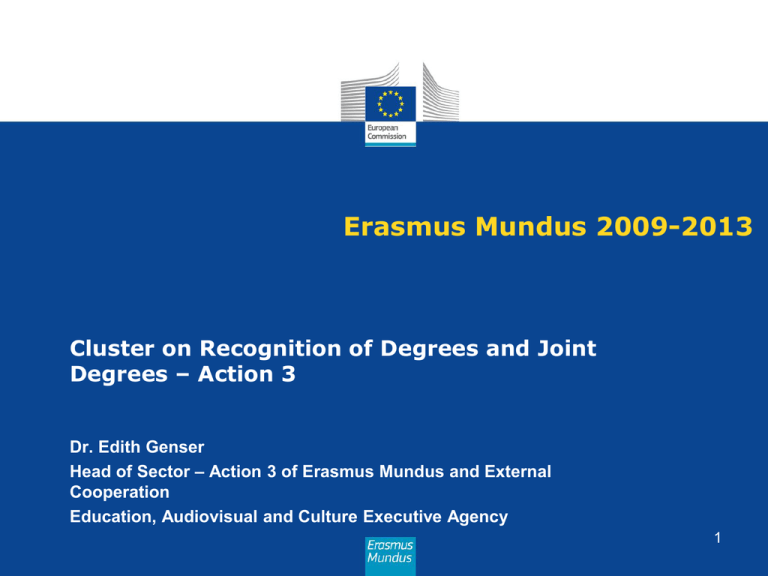
Erasmus Mundus 2009-2013 Cluster on Recognition of Degrees and Joint Degrees – Action 3 Dr. Edith Genser Head of Sector – Action 3 of Erasmus Mundus and External Cooperation Education, Audiovisual and Culture Executive Agency 1 Clusters - Objectives • disseminate the results • exploit synergies • identify good practices & exchange experiences 2 5 Cluster Themes • • • • • Sustainability Employability Recognition of Degrees and Joint Degrees Regional Cluster - Asia Thematic Cluster – Climate Change Mitigation and Sustainable Solutions 3 The Survey • Online: combined survey with closed and open Questions • • Closed: Numerical overview Open: Rich set of write-in comments supplemented by interviews • Online 25th October to 6th December 2011 • Follow-up interviews 4 Target Groups & Response Rates Recognition and Sustainability Survey Contacted Responded % Response Rate Master Course (EMMC) coordinators 123 87 71% Master Course (EMMC) partners 535 125 23% Master Course (EMMC) associate members 393 36 9% Brand Names (EMBN) coordinators 15 3 20% Brand Names (EMBN) partners 69 5 7% Brand Names (EMBN) associate members 60 6 10% Joint Doctorate (EMJD) coordinators 24 19 79% Joint Doctorate (EMJD) partners 111 30 27% Joint Doctorate (EMJD) associate members; Erasmus Mundus Students (212) and Graduates (526) 186 26 14% 7000 808 12% National Structures Action 2 Projects 30 74 24 12 80% 16% Action 3 Projects 42 13 31% n.b. The response rates by question for students and graduates, because some respondents chose to skip certain questions 5 Recognition • EUROPEAN: Activities at the EU and EHEA Levels • INFORMATION: Support for students and graduates • LEGAL: Legislative enablers and impediments • STUDENTS: What are the student experiences? • INTERNATIONAL: Activities of EM Joint Programmes, Actions 2 and 3, and National Structures • CAREERS: What do employers need? 6 Recognition Outcomes: Cross-Cutting Themes • Supporting students • Information from application through to graduation 76.5% satisfied with information provided by the course about degree type, but only 32.6% satisfied with information about recognition • Overcoming challenges of joint degrees • Collaboration with National Structures, policy influence, Bologna Process and HE reforms National Structures report broad legal recognition of EMJCs by countries (45%), some (27.5%), none (27.5%) • All actors raise global visibility of Erasmus Mundus • From European Commission to Students and Alumni Building strong alumni networks; promotion and publicity; academic and professional links; connection to business, research and employer networks 7 Recognition Outcomes - Complexity • No single Erasmus Mundus Degree, but instead a ‘cloud’ of degrees are issued by EMJPs around: • Double degree; Multiple degree; Joint degree Graduates: 12% received Multiple Degrees and 22% Joint Degrees signed by all consortium HEIs. 43% of graduates received a Joint or Double degree issued only by the Universities where they studied • Presents significant recognition challenges for EMJPs • Each cohort of degrees influenced by where students ‘take’ them, constraints imposed by mobility pathways, accreditation challenges, national legislation … • 74% of students and graduates note EM degrees have particular added value, but National Structures report challenges in the added value being recognised widely by policy makers and HEIs 8 Recognition Outcomes - Students • • • Graduate experience about degree recognition • Graduates: 58% experienced legal recognition in Europe for further study, and 47% for employment. 40% and 43% for home country recognition 76% well supported with information during the course • 53.5% satisfied throughout; 18% had improved information about employer recognition, 12.5% about legal recognition Just over half satisfied with information given about ECTS and Diploma Supplements etc. Range of good practice: • “I received information about the structure, career prospects, networking opportunities and the quality of degree I stand to obtain from the consortium of universities after successful completion of the course” 9 Recognition Outcomes - Students • • • Joint and Double Degree awards prevail Uneven timeliness in the provision of certificates and associated information to students • 33% of students received their degrees within 3 months of graduation, and 17% waiting a year later “One of my schools from France delivered to the original degree really late - about a year late. The other two schools from Finland and the Netherlands awarded the degrees to me on my graduation day” Priorities for action are: • Legal recognition in Europe for further study & employment “Due to its multi-disciplinarity, my degree was not recognised as an ‘education' master degree by a Swedish university when applying for PhD studies” • Recognition back in graduates’ home countries 10 Recognition Outcomes - Degrees • • • 51% of Coordinators expect to award Multiple or Joint degrees signed across the consortium • 61% of coordinators note provision of Joint Diploma Supplement relevant to the overall course; 19% Individual Diploma Supplement from all hosting HEIs Students and graduates are active ‘recognition players’ • Actively seek information from home HEIs, colleagues and friends, agencies (NARIC, QAAs, National Organisations) • But graduates note the often long time to undergo recognition processes once they have their degrees Formal legal and professional recognition vital • But employers more understanding about the EM degree where legal recognition is not present 11 Recognition Outcomes - Doctorates • Recognition challenges less concern than for EMMCs • “The experience of the EMJD in Law and Economics (EMJD) - which started as a joint doctorate programme in 2005 already - learns that all of the doctorate graduates have no problem at all to find a suitable job, most of the time at a university or as a consultant” • Integrating examination practices in partner countries can be bigger challenge than external recognition • “The main challenge is the credit equivalencies for the Joint Doctoral Programmes. This is especially so for proposed joint degrees between a European and a Southeast Asian university” .. “will this PhD be recognised by employers” • Graduates yet to ‘test’ recognition in the labour market • “The doubt on the need to have two PhDs is still strong in our country, so it is important for the potential students to realise how and why having two or more PhD is useful for their future” 12 Summary - Recognition Outcomes • • Some issues are beyond direct Coordinator control • Legal issues and regulations (Institutional to National) • Complexity of the overall recognition process • Time taken to formally award degrees • Slow delivery of certificates & formal documentation • “I think the main challenge is the diversity of institutional regulations and practices and relative rigidity. This may also linked to funding systems. But as joint degrees become more common I suspect that problems are ironed out” Overall degrees from EMJPs have added value, but that value is delivered through innovative complexity which introduces recognition challenges • “Helpful if the consortium in coordination with resident EU delegation supports dissemination about the program, degree, and content of the course and how it is linked to contemporary economic and political development in countries” 13 Summary - Recognition Outcomes • • • • • Considerable work by coordinators and course teams Institutional imperative to maximise recognition National Structures have pivotal roles in bridging national and international recognition processes • Supporting excellence: “What we need is a shared European methodology to assess the quality of joint programmes” Actions 2&3 help to increase EM Global visibility • Action 3 projects provide a bottom-up support for HE reform and capacity building “We produced a good practice booklet on the recognition of Asian degrees for acceptance into European HEIs” In terms of its volume activity compared to overall global Master and Doctoral programme activity, the Erasmus Mundus Programme has an impact beyond its scale 14 Common methodology and outputs Status Oct 2012 Sustainability Employability Recognition Asia Climate change Survey Workshop Publish guidelines Dec 2012 Publish survey report Autumn 2012 15 Recognition – Documents and Info • Clusters / Studies Action 3 within Erasmus Mundus: http://eacea.ec.europa.eu/erasmus_mundus/clusters/ index_en.php 16 Recognition – Documents and Info Action 3 Project of Erasmus Mundus: http://eacea.ec.europa.eu/erasmus_mundus/results_compendia/s elected_projects_action_3_achievements_activities_en.php • BRIDGE NARIC: EMNS project to share best recognition practice • JOQAR: knowledge base and guidelines on degree recognition • ADDE SALEM: specific focus on joint EU-LA degrees in engineering 17 Action 3 Projects on Recognition • LEANES: best practice model on assessment of Asian qualifications • EM-IDEA: tools and services available to coordinators of joint programmes, with a focus on recognition issues • INTER-HED: on-line training course for the management on joint programmes (Module 3: Recognition process) • EAR – European Area of Recognition Manual (LLP, 2012): Practical guidelines for fair recognition and assessment of qualifications awarded by joint programmes 18 KEYWORDS RECOGNITION • • • • • • Collaboration, Dialogue, Communication Quality, learning outcomes Flexibility, Creativity Transparency Networking Reference actors: NS, NARIC-Centres, Bologna Experts, EU-Delegations, Accreditation Agencies, Network of EM-Coordinators, EMA 19 RECOGNITION - OUTCOMES Contact: EACEA Edith GENSER Edith.Genser@ec.europa.eu 20
